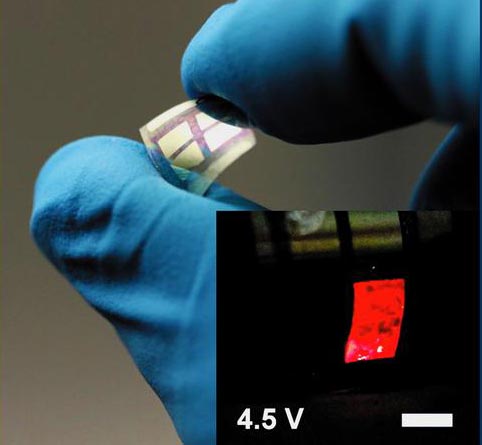Scalable Growth Process: Flexible Light Emitting Elements in 2D

Foil with 1 cm edge length, containing four emitter elements. The insert shows one of them in operation. The scalebar is 2 mm.
Andrzejewski et al., Advanced Optical Materials 2020, 2000694, Published by Wiley-VCH, Weinheim
If 80,000 of them were piled on top of each other, the stack would only be as high as a flat sheet of paper. Scientists from the Center for Nanointegration (CENIDE) at the University of Duisburg-Essen (UDE) and cooperation partners have developed a layer of tungsten disulfide that is just as thin as three atomic layers – and it is luminous, flexible and also withstands external influences. Several square centimeters of this layer have already been embedded in structural components, but the manufacturing process is scalable beyond that, the trade journal Advanced Optical Materials reports.
The wafer-thin luminescent layer grows on a sapphire base, is then carefully removed with the aid of a lacquer and transferred to the carrier film. The lacquer is then dissolved. In broad terms, this is the manufacturing process the project partners from UDE, RWTH Aachen University and AIXTRON used to develop entire devices from the two-dimensional material. The method can be scaled to much larger areas using the same material and the same device architecture, and this is what makes it interesting from an industrial point of view.
Change the Bending to Change the Light
Led by UDE’s Professor Gerd Bacher, lighting elements were created that combine the advantages of different component concepts: The inorganic tungsten disulfide layer is less susceptible to harmful environmental influences such as oxygen or moisture and is also long-term stable. Due to the flexible design, the structure adapts to any shape. But the flexibility has even another advantage: if the film is bent, the crystal lattice of the luminous layer is distorted and the wavelength of the emitted light – and thus the color of the light – changes. Although this difference is not visible to the naked eye, it is easy to detect with measuring instruments.
“This is what makes the elements interesting as sensors, for instance,” explains Dr. Tilmar Kümmell from the Bacher working group. “We think they could be used to detect deformation or distortions.” On the other hand, the precise bending of the film would also make it possible to select a specific wavelength for the emitted light.
Editor: Birte Vierjahn, +49 203/37 9-8176, birte.vierjahn@uni-due.de
Wissenschaftliche Ansprechpartner:
Dr. Tilmar Kümmell, Electronic Materials and Nanostructures, +49 203/37 9-3403, tilmar.kuemmell@uni-due.de
Originalpublikation:
D. Andrzejewski, R. Oliver, Y. Beckmann, A. Grundmann, M. Heuken, H. Kalisch, A. Vescan, T. Kümmell, G. Bacher
„Flexible large-area light-emitting devices based on WS2 monolayers“
Advanced Optical Materials 2020, 2000694
https://doi.org/10.1002/adom.202000694
Media Contact
All latest news from the category: Power and Electrical Engineering
This topic covers issues related to energy generation, conversion, transportation and consumption and how the industry is addressing the challenge of energy efficiency in general.
innovations-report provides in-depth and informative reports and articles on subjects ranging from wind energy, fuel cell technology, solar energy, geothermal energy, petroleum, gas, nuclear engineering, alternative energy and energy efficiency to fusion, hydrogen and superconductor technologies.
Newest articles

Scientists transform blood into regenerative materials
… paving the way for personalized, blood-based, 3D-printed implants. Scientists have created a new ‘biocooperative’ material based on blood, which has shown to successfully repair bones, paving the way for…

A new experimental infection model in flies
…offers a fast and cost-effective way to test drugs. Researchers at the Germans Trias i Pujol Research Institute and Hospital have reinforced their leading role in infectious disease research by…

Material developed with novel stretching properties
KIT researchers produce metamaterial with different extension and compression properties than conventional materials. With this material, the working group headed by Professor Martin Wegener at KIT’s Institute of Applied Physics…



